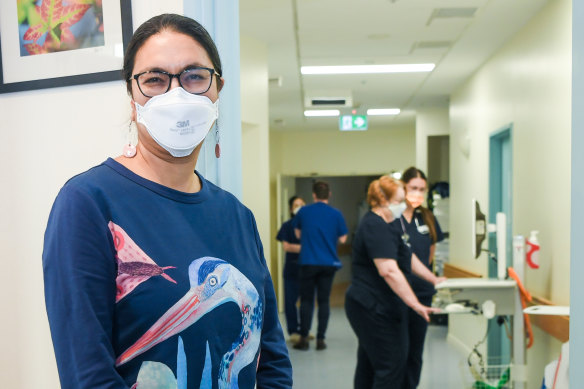Key points
- Australian women are feeling more burnt out and more likely to be thinking about leaving their jobs than their global peers.
- Thirty-nine per cent of Australian women feel pandemic burnout may be hampering their career progression.
- Fathers who took on more care and home duties in the last two and a half years, and stuck with it, are also feeling professional and personal pain.
Nisha Khot is used to a carrying decent load. As a hospital clinical director, obstetrician and mother of two, she was accustomed to the work-family juggle well before the pandemic.
She did her best to support friends and colleagues doing it tough in 2020, doing “anything I could do to help”, but by the time Victoria’s second long lockdown landed this time last year, Khot found she was running on empty.
“It was just too difficult, I found that I just wasn’t interested. Essentially, I gave up.”
Nisha Khot observes women feeling burnt out by the extra burdens of pandemic life around her, and experienced the ‘gender burnout gap’ herself.Credit:Justin McManus
Now, though refreshed after leaving her role at Bacchus Marsh Hospital and taking three months to regroup, Khot realises she was a statistic in what researchers have dubbed the post-pandemic “gender burnout gap”.
She sees walking examples of it all around her.
“What I see is, women are just tired, I constantly hear, ‘we’re tired, we’re exhausted’,” says Khot, who has just returned to management work as clinical director at Frankston Hospital.
“Women have traditionally relied on support mechanisms [to juggle work, kids and a greater share of home duties than most male partners] … and what the pandemic showed us was when those mechanisms fall away, the burden on women is disproportionately high.”
The global study Women @ Work 2022, by accounting giant Deloitte, revealed in May that Australian women are feeling more burnt out and more likely to be thinking about leaving their jobs than their global peers.
Five thousand women across 10 countries were surveyed. Half of the Australian working women surveyed reported post-pandemic burnout, half want to leave their job in the next two years as a result and one-third have taken time off for a mental health issue.
In a soon-to-be-released book, Leaning Out, Melbourne gender equality commentator and former Our Watch adviser, Kristine Ziwica notes that several longitudinal Australian studies have measured the heavier weight of home chores and childcare that fell on working women in heterosexual families during the pandemic, and the impacts of that.
“Even before the pandemic there was always what’s called a burnout gender gap, meaning women were more likely to experience burnout at work,” says Ziwica, a former adviser to the UK’s End Violence Against Women Coalition.
“But the pandemic turbocharged that gap: the size of the ‘burnout gender gap’ has more than doubled since 2019 according to a 2021 Gallup poll.
“The pandemic has given rise to numerous … mental health challenges for women, including this really virulent strain of burnout which has disproportionately affected women, especially mothers and women from diverse backgrounds and in caring professions.”
Professor Leisa Sargent, of the University of New South Wales Business School, notes 39 per cent of women felt pandemic burnout may be hampering their career progression.
“Fundamentally, it’s because of care responsibilities, but also, women have been in those caring-job roles as well: they’re jobs that have high emotional content attached to them,” she says.
Fathers did step in with housework and childcare, and where they did what women have been doing forever they also suffered.
Structural changes, including making the paid parental leave scheme more egalitarian and introducing a “use it or lose it model” could “reshape gender norms and expectations”, as has been done successfully in some European countries, both Sargent and Ziwica argue.
But, such is the toll of the work-life juggle in the pandemic era, research this month by Melbourne University shows that fathers who took on more care and home duties in the last two and a half years, and stuck with it, are also feeling professional and personal pain.
Leah Ruppanner, associate professor of sociology at the University of Melbourne, said the latest survey of 1000 people participating in her longitudinal study of pandemic life [with colleague Dr Brendan Churchill], found 80 per cent said they felt burnt out, and fathers who lifted their domestic participation were feeling similar strains to women.
“Nowhere else [in the world] had fathers in the home for as long as Victorian fathers were, and they suffered emotionally from it,” says Ruppanner.
“Fathers did step in with housework and childcare, and where they did what women have been doing forever [juggling work and family responsibilities] they also suffered.”
Ziwica, whose book title is a play on Lean In, Facebook chief operating officer Sheryl Sandberg’s decade-old call to women to take responsibility and push their own careers harder, says big changes, not individual strategies are the solution to the big burnout wave dumping many working women.
Some promising signs of change are emerging, she says. “The solutions are all in tackling the systemic … We have to fix the systems: unequal distribution of unpaid caring work in heterosexual relationships, cost and availability of care, lack of flexible work with real career pathways, gender discrimination at work, racism, [and] ableism,” she says.
“That was the ‘big lie’ of Lean In, that the solutions to all sorts of gender gaps, including the burnout gender gap, could be individual … more lunchtime pilates isn’t going to fix it.”
The Morning Edition newsletter is our guide to the day’s most important and interesting stories, analysis and insights. Sign up here.
Most Viewed in National
From our partners
Source: Read Full Article
